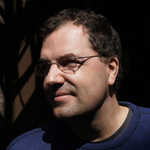This is the second of a projected series of Science Fiction titles called to mind from youth — stories that made me, or at least contributed to what I was destined to become. My project is to create images that depict, or at least in some way relate to, those well remembered novels or stories. So far, I’ve had fun with the idea, but have found the picture taking far more challenging than I ever imagined it would be.
In this image I am standing before a portal looking into the unknown. By simple manipulation of the device in my hand, I will find myself transported to another moment in time, or to another planetary world, or even perhaps to an alternative or parallel universe. The notion of the magic portal to other times and places must be one of the most widely used memes not only in SciFi, but also in Young Adult or Children’s Fiction. Consider: Alice in Wonderland (1865) by Lewis Carroll; The Lion, the Witch and the Wardrobe (1950) by C. S. Lewis; and the wonderful A Wrinkle in Time (1962), by Madeleine L’Engle, all of which I read to (or with) my daughter Susannah.
In Science Fiction my first encounter with the portal idea came in Robert Heinlein’s Tunnel in the Sky (1950) in which an expedition of young people is sent from an overpopulated earth by way of the Ramsbotham Jump to another planet where they became stranded for a time enjoying Lord of the Flies like adventures. This example constitutes both the most common and, for me, the least interesting use of the portal: a sort of quick-acting space ship.
A far more satisfying application of the concept is found in Andre Norton’s novel Stargate, (1958), likely the first time that very familiar title was put into service. I remember reading the book in ‘58 — at the very time I was also devouring Anna Karenina. And, even though I had already completed two semesters of Russian language, the customs and behaviour of the Muscovites seemed only a little less strange to me than that of the Gorthians (detailed in the potted GoodReads summary below). Of course, it is not particularly original to suggest that the device of the novel itself (whether scifi or not) is a kind of portal to other worlds.
When Kincar s’Rud, of mixed Gorthian and Star Lord blood, passed through the shimmering gate that led to a parallel universe, he found himself on a Gorth entirely different from the world he had known. Even his former Gorthian friends turned out to be his enemies. For they were the people his friends might have been, had they made different choices at crucial moments in their lives. And though Kincar found new allies, they too were soon forced to confront their own evil, might-have-been selves.
One final example that sticks in my memory occurs in Dan Simmon’s Hyperion Cantos series (1989). Here, a network of portals called “farcasters” connect most human-inhabited planets into one giant World Web so that the tyranny of distance is finally defeated. Best of all is his brilliant concept of houses in which each room is built on a different planet, joined by farcaster portals.
See also: Dark Universe
Other moments in Aireys Inlet
-
Burning, poem, Books
Burning the Books
in Aireys Inlet, Australia -
Today's Sunrise, poem
Beginning or End?
in Aireys Inlet, Australia -
Verses for Emlyn, Grandfathers, family fun
Grandad Wade
in Aireys Inlet, Australia -
Verses for Emlyn, Roses, flowers
Beauty
in Aireys Inlet, Australia -
The Small Things, Depression
Small blessings #4: Just a touch of rose.
in Aireys Inlet, Australia -
Verses for Emlyn, birds, bird bath
Seven
in Aireys Inlet, Australia -
Atheism, Today's Sunrise
Glory
in Aireys Inlet, Australia -
Today's Sunrise, Today's Coffee, health
Morning Cuppa
in Aireys Inlet, Australia -
Verses for Emlyn, kangaroo, wildlife
Alert
in Aireys Inlet, Australia









